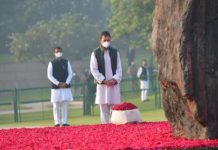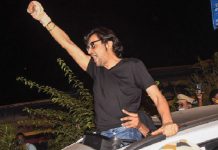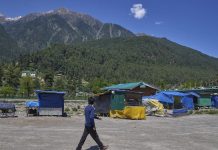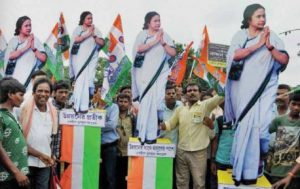 Recurring incidents of violence either on the pretext of elections or religion that have made the state of West Bengal as a witness to severe political turbulence, especially in recent months, reminds us of the famous Hindi adage, which translates to earth has erupted because of sin, immorality has made the sky to explode and treachery has made humanity to tremble and the demons are having a field day.
Recurring incidents of violence either on the pretext of elections or religion that have made the state of West Bengal as a witness to severe political turbulence, especially in recent months, reminds us of the famous Hindi adage, which translates to earth has erupted because of sin, immorality has made the sky to explode and treachery has made humanity to tremble and the demons are having a field day.
In its mad race for deepening its roots on the political soil of West Bengal, the BJP is adhering to all means available at its disposal, including the Central government machinery to dislodge the democratically elected and popular government of the Trinamool Congress (TMC) led by chief minister Mamata Banerjee.
Undoubtedly, eruption of tension and sometimes violence on account of political differences between the political rival parties ahead of elections is a general phenomenon. Nevertheless, it has taken the ugliest form in West Bengal this time, especially on the eve of general election.
There have been exchange of allegations and counter allegations between the TMC and the BJP over issues pertaining to corruption, use of Central and state agencies and conflicting claims over the success of social welfare schemes by the state and Central governments.
Both the BJP and the TMC are said to have been accusing each other of killings, beatings, vandalism and making false allegations to the police. In the wake of disruption of a public meeting of the BJP reportedly by the TMC workers in January this year, the BJP workers thrashed the TMC workers in retaliation, smashed their vehicles and burnt their party office. According to media reports, a local BJP leader had exhorted the party workers: “Stand up and protest, Trinamool Congress will run away in fear.”
The state of West Bengal, with 42 Lok Sabha seats, holds significance for any political party scrambling to form government at the Centre. In the outgoing Lok Sabha, the TMC had 34 MPs, Congress had four MPs, and the BJP and the CPI (M) had two each.
Having been out of the electoral pale prior to 2014, the BJP became politically more ambitious after having won two seats in 2014 general election with improved voting percentage and its good performance in the local panchayat polls subsequently proved a morale booster for the party. Uncertain of its ‘clean sweep’ in the Hindi heartland, the BJP has high stakes in West Bengal in the 2019 general election.
Different Politics
The state of affairs pervading West Bengal politics is different from that of UP, Bihar, Maharashtra, Kerala or Tamil Nadu, where ruling parties or coalitions change frequently and Lok Sabha fortunes vary dramatically. It is said that West Bengal doesn’t have caste-based politics and that is why there could not develop caste-based parties like Rashtriya Janata Dal (RJD) in Bihar, Samajwadi Party (SP) and Bahujan Samaj Party (BSP) in UP. According to some experts, in West Bengal there are at least eight broad caste groups, with at least 13 strains of Brahmins and four varieties of Baidyas at the top and around 13 different kinds of Dalit at the bottom.
The Barga movement started in the early 1970s in West Bengal under the Congress rule was designed to allot land to small and marginal farmers. Each block had an advisory committee, which included, among others the block development officer and a local party representative and this committee was said to have reach to every household in very village and mohalla.
Subsequently, under the Left rule in West Bengal caste remained relegated to the background and only class was defined by economics. The Left cadre held a sway on each village committee. Under the Left rule, these village committee began to play significant role in deciding all issues, including family disputes.
Enhanced powers of the village committee in managing village affairs, including the distribution of fodder and fertilizers, gave the Left cadres full hold on rural politics. The rural and urban elite was absorbed in administrative and other jobs in return for loyalty to the party. The TMC’s strategy of gradual penetration through Panchayats and its winning streak from the panchayats in 2008 onwards enabled it to wrest power from the Left in 2011.
TMC’s tactical stratagem
By 2008, TMC had managed to wrest panchayats from the Left and began taking over the formidable village organizations and by the time TMC swept to power in 2011, Left ‘cadre’ had become Didi’s ‘bhais’.
The TMC under Mamata Banerjee was swept to power on the slogan of Maa, Maati, Maanush, the slogan that gained prominence during the mass movement against the Left Front government-sponsored land acquisition in the villages of Singur and Nandigram.
After coming to power in 2011, Mamata Banerjee announced a slew of welfare measures like Kanyashree — a scheme to empower girl child through education — and Khadya Sathi scheme of providing rice at 2 to ensure food security to 90 per cent people in the state.
Popularity of the TMC rule helped it to retain power for the second time with increased number of seats in the state assembly in 2016.Nevertheless, the TMC government is on the backfoot on the question of providing jobs, especially in the wake of media reports indicating large numbers of educated and uneducated, skilled and non-skilled people moving out to other states for greener pastures.
BJP’s manoeuvrability
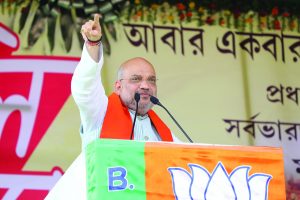 Having won two Lok Sabha seats in 2014 along with jump in its vote share up to 17 per cent from its miserable 2009 tally of 9 per cent, the BJP in West Bengal was buoyed up. However, this glee over vote share jump proved short-lived because in 2016 StateAssembly elections, the BJP’s vote share tumbled to 10 per cent.
Having won two Lok Sabha seats in 2014 along with jump in its vote share up to 17 per cent from its miserable 2009 tally of 9 per cent, the BJP in West Bengal was buoyed up. However, this glee over vote share jump proved short-lived because in 2016 StateAssembly elections, the BJP’s vote share tumbled to 10 per cent.
Nevertheless, the party leadership has continued to nurture high electoral hopes from West Bengal. Electoral significance of West Bengal started receiving added emphasis in BJP’s overall strategy in the aftermath of party’s loss of three states in the Hindi Heartland in November 2018 along with agrarian distress, slow jobs growth and Opposition alliances entailing the potential of undermining electoral prospects of the BJP in northern Hindi Belt in 2019 general election.
In its attempt to compensate the loss in the north, the BJP leadership has been driving hard to pick up support in West Bengal and this push has set Modi-Shah duo and the party on a collision course with Mamata Banerjee.
With increased frequency of addressing rallies in different parts of West Bengal, Modi-Shah duo have tried to project the BJP as the principal opposition party in the state. Even the top brass of the BJP has not shunned from evoking religious passions of the Bhadralok to garner votes.
According to some experts, BJP president Amit Shah’s speeches have often flagged emotional touchpoints among the state’s Hindu population, alluding to how cows wouldn’t be smuggled into Bangladesh from West Bengal were the BJP to come to power. How Hindu refugees would receive citizenship. Cross-border infiltration of Bangladeshis would stop. Payoffs to political-business syndicates would end etc.
The BJP, according to some experts, has been leveraging three emotive issues — the Citizenship (Amendment) Bill, National Register Commission and Bangladeshi immigration — through holding a series of mega rallies in West Bengal headlined by top BJP leaders, including PM Modi himself, to influence voters in Bengal.
Undoubtedly, one of the BJP’s main charges against Mamata is about her “appeasement politics”, nonetheless, the Muslim voting population, standing at above 27 per cent, constitutes a solid support base for the TMC. Besides, Mamata Banerjee has been at the forefront of opposing the NRC and the Citizenship Amendment bill, alleging that the bills are aimed at making people stateless refugees.
Rather than emphasizing on its national agenda of driving economic growth and providing jobs along with affordable housing, the BJP in West Bengal has been concentrating more on
accusing TMC of corruption and Mamata Banerjee of running a dictatorship.
Media have extensively reported state BJP leadership’s open exhortation to party workers for carrying “batons, bamboos and goons attack you, you hit back. So, we are fighting back.” Local party leaders began to spew aggressive language. These activities have become more pronounced from 2017 onwards gaining further momentum in early 2019.
Way forward
Modi’s recent claim that 40 TMC MLAs were ‘in touch with’ him indicate BJP’s desperation for power even by destabilizing the democratically elected TMC government by engineering defections. The BJP president is hopeful of his party winning twenty plus Lok Sabha seats.
However, many experts don’t subscribe to this assessment by arguing that even with 17 per cent of vote share of the BJP at 2014 level, which declined to 10 per cent in 2016, it is a herculean task for the party to reach that magical number.
These analysts further aver that to make a dent, let alone win, the BJP needs to appropriate not just the propaganda platform but also the political infrastructure. Besides, the ruling TMC can’t be expected to yield ground without a tough fight.
Conceding that the BJP’s vote share will increase in this general election, analysts are wary about the BJP winning more than maximum five seats. They also don\t rule out the possibility of ratcheting up of the ongoing rhetoric during the Lok Sabha elections snowballing into confrontation for ensuing assembly polls in early 2021.
Dr. Anil Singh is Executive Editor of News24. Views expressed are his own
letters@tehelka.com








